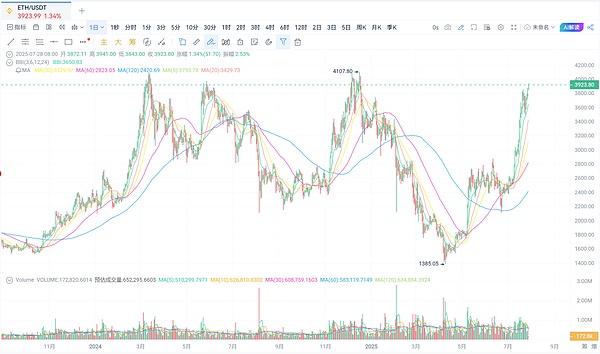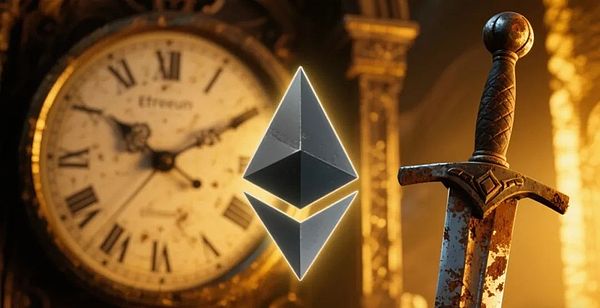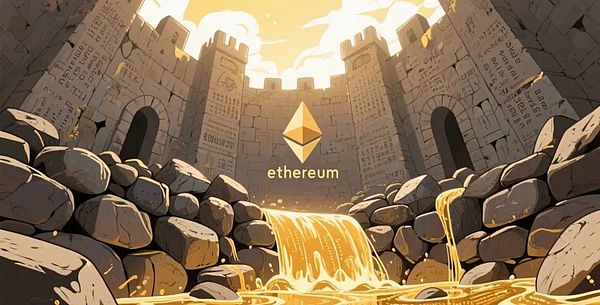Ten years of ups and downs, a gorgeous transformation of digital assets
On July 30, 2025, Ethereum's Genesis block will usher in the 10th anniversary,In 2013, the 19-year-old Vitalik Buterin wrote in the white paper: "Blockchain should not only record accounts, but also run programs." At that time, Bitcoin players sneered: "Is this kid suffering from a middle school syndrome?"

As a result, ten years later, this "middle school concept" has grown into
Just last week, my friend, a fund manager who used to only buy gold, sent me a message: "Help me buy some Ethereum, but don't tell my mom."Institutional investors are pouring into Ethereum at an unprecedented rate. Listed companies such as BitMine and Sharplink Gaming have hoarded more than 1.3 million ETH, worth billions of dollars - as if a gold rush in the digital age is taking place.
1. Price roller coaster, the engine of the bull market has been ignited
The Ethereum market in the past six months has been more exciting than a roller coaster.

In the darkest moment of April, ETH fell below $1,500, a 65% plunge from its historical high in December 2024. At that time, the trading group around my coffee cup was dead silent, and some people even began to discuss the possibility of switching to delivering food.
The counterattack in July caught everyone off guard.In just one month, the price of ETH soared from $2,551 to $3,707 (as of July 24), a surge of nearly 50%. What is even more amazing is that the ETH/BTC exchange rate soared by 36% in one month. Ethereum finally got rid of the shadow of Bitcoin and began to move out of an independent market.
At this moment, standing at the $3,900 mark, the entire crypto community is holding its breath and staring: When will the psychological defense line of $5,000 be broken? Galaxy Digital CEO Mike Novogratz's prediction represents the voice of most people:"ETH is destined to hit $5,000, and after breaking through, it will start the price discovery mode."
Analysts' forecasts range from a conservative $4,308 (the average of the Finder expert group) to a radical $8,000 or more. When I saw Eric Trump publicly support the view that "ETH should exceed $8,000" on Twitter, I realized: Ethereum's narrative has changed completely .
Two. Ten years of transformation, from smart contracts to financial infrastructure
Looking back on the evolution of Ethereum is like watching a theory of the evolution of technology finance:
2015-2019: A testing ground for idealism
The concept of “world computer” in the white paper amazed the world, but the congested network and sky-high gas fees made the CryptoKitties game paralyze the entire system. At that time, ETH was more like a geek toy.
2020-2022: Engine of DeFi Revolution
With the explosion of decentralized applications such as Uniswap and Aave, Ethereum has become the base of financial Lego blocks, and merged upgrades have completed the gorgeous transformation from energy-consuming Proof of Work (PoW) to energy-saving Proof of Stake (PoS).
2023 to present: The rise of institutional assets

Why is Ethereum called "the Android system of the blockchain world"?
Bitcoin is like Nokia: it can only make calls and send text messages; Ethereum is Android: anyone can develop an app. Where is its moat?
1. Ecology has become the "water, electricity and coal of the digital economy"
• DeFi (decentralized finance): Uniswap's daily trading volume is half of the Shanghai Stock Exchange;
• NFT (digital assets): Bored Ape sold for 1 million dollars, Jay Chou also collected it;
• Stable currency overlord: 80% of USDC and USDT run on Ethereum, with an average daily settlement of 12 billion US dollars...
2. Technological upgrading is like “installing rocket engines on highways”
• Sharding technology will be implemented in 2025: transaction speed will increase from 15 transactions per second to 100,000 transactions per second, and handling fees will increase from US$10 to US$0.001;
• zkEVM is launched: privacy computing makes on-chain transactions more confidential than Swiss banks, and Goldman Sachs are lining up to enter the market;
• The threshold for staking has plummeted: in the future, you can become a “blockchain shareholder” with 1 ETH (about US$3,000) and earn an annualized return of 6-8%.
3. Policy "Green Lantern" Possession
The U.S. Congress passed the CLARITY Act, which recognized ETH as a commodity rather than a security; the GENIUS Act broughton-chain stablecoins under regulation - compliance is equivalent to issuing admission tickets to institutions.
When BlackRock issued the BUIDL fund on Ethereum, and when JPMorgan Chase launched deposit tokens on Base L2, traditional financial giants voted with real money -Ethereum officially became a financial infrastructure.
The most critical transformation occurred in the field of value storage. More than 33 million ETH were pledged (accounting for about 26% of the circulation), and the burning mechanism of EIP-1559 formed a deflationary spiral, and its annual inflation rate was compressed to below 1.5%, even lower than the gold mining rate. When the purchasing power of fiat currency continues to be diluted by policies such as the "Big and Beautiful Act", this digital scarcity is particularly valuable.
Three or four engines ignite the explosion of Ethereum's value
The fundamentals that currently drive Ethereum constitute a solid value support network:

Engine 1: "On-chain Treasury Bonds" in Corporate Treasury
The latest data shows that the ETH reserves in the treasury of listed companies have exceeded 730,000. Machine even plans to go public through a backdoor listing with 400,000 ETH. These companies regard ETH as an interest-bearing strategic reserve asset, just like a country holds gold reserves.
Engine 2: ETF opens institutional taps
Since the spot ETF was approved in July 2024, institutional funds have net inflows of $4.2 billion. What is even more shocking is that the Ethereum ETF has surpassed the Bitcoin ETF in terms of capital inflows for seven consecutive days. Once the valve of traditional finance is opened, the torrent of funds is unstoppable.
Engine 3: RWA becomes a value anchor
The tokenization of real-world assets is creating a $16 trillion market. Of the total RWA issuance on the current chain, more than 70% occurs on Ethereum and its Layer2 network. When industry giants such as BlackRock and Franklin Templeton choose Ethereum to issue tokenized funds, its position as a "financial layer" has been consolidated.
Engine Four: Technology Upgrade to Reduce Costs and Increase Efficiency
The Pectra upgrade in May 2025 is like replacing a new engine for Ethereum: the efficiency of smart contracts is improved, the transaction costs of Layer2 are greatly reduced, and the Gas fee problem that once plagued developers is being resolved by modular architecture and L2 solutions.
Fourth, the battle between two giants, the new order of the public chain battlefield
When Solana attracted the Meme coin carnival with its cheap transaction fees (BONK’s market value has exceeded 2.6 billion US dollars), some people began to question Ethereum’s dominance. But a deeper look reveals that the two public chains are differentiating into completely different ecological niches: - Ethereum = Financial Hub: It occupies an absolute share of 61% of the total DeFi locked amount (TVL) in the entire network, becoming a "safe safe" for the issuance of high-value assets - Solana = Consumer Paradise: It supports high-frequency trading scenarios with extreme speed and low fees, and becomes a "traffic playground" for Meme coins and social applications. Grayscale continues to increase its holdings of ETH as ETF reserves, while Jump Trading has made a large-scale layout of SOL eco-coins - capital has voted for a "dual-track system" with real money. This is like the serious investment banks on Wall Street and the noisy billboards in Times Square, each has its own value.
But when I saw that the monthly active developers of Ethereum were stable at 50,000 (4 times that of Solana), I understood:
The gathering place of innovative talents is the real moat of blockchain. For ordinary people, my observation framework is:
Risk buffer : Experts predict that it may retreat to $1,940 in 2025. Make sure you can withstand fluctuations of more than 30%
Value scale : Pay attention to the ratio of on-chain stablecoin reserves (currently $131 billion, doubled from a few months ago) to ETH market value. The 3.4x indicator shows that ETH may be undervalued
Time leverage
In the past ten years, Ethereum has transformed from a geek toy to an institutional treasury. When listed companies included ETH in their balance sheets and when Federal Reserve Board members began to cite the Ethereum white paper, the results of this social experiment have become clear.
If you believe that the digital world will eventually reconstruct reality - then Ethereum is the infrastructure maniac holding the blueprint.
 Weatherly
Weatherly








